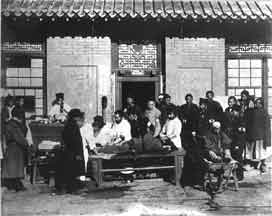1937 Sino-Japanese War Resumed
On July 7th,1937 Japanese troops clashed in maneuvers with Chinese troops at the Marco Polo bridge, ten miles west of Peking. Three weeks later, the Japanese invaded in large numbers. In order to circumvent the pledge made in the Kellogg Pact, Japan did not officially declare war, but called the event the "China Incident." President Roosevelt took advantage of Japan's reluctance to declare war, using it as a loophole in the neutrality act allowing the United States to continue shipment of weapons to the Chinese. .
On July 7th, 1937, tensions between Japanese and Chinese forces escalated when Japanese troops engaged in maneuvers near the Marco Polo Bridge, located approximately ten miles west of Peking (now Beijing). The encounter quickly turned into a clash with Chinese troops, marking the start of a conflict that would eventually escalate into a full-scale invasion.
Three weeks later, on July 28th, the Japanese launched a large-scale invasion of China, initiating a prolonged period of military aggression. However, in a strategic move to avoid international condemnation and navigate the restrictions of international agreements, Japan refrained from officially declaring war. Instead, they referred to the invasion as the "China Incident" or the "China Affair."
This labeling allowed Japan to exploit a loophole in the Kellogg Pact, an international treaty renouncing war as an instrument of national policy. By avoiding a formal war declaration, Japan aimed to circumvent the diplomatic consequences and potential backlash from the international community.
Amidst this delicate situation, President Franklin D. Roosevelt of the United States skillfully utilized Japan's reluctance to declare war to his advantage. Roosevelt recognized the ambiguity of Japan's actions and used it as a means to exploit a loophole in the U.S. neutrality act. This act restricted the shipment of arms and military aid to nations engaged in hostilities.
By capitalizing on Japan's non-declaration of war, President Roosevelt maintained a legal justification to continue the shipment of weapons and military support to China. This decision enabled the United States to support the Chinese resistance against the Japanese invasion without violating the neutrality act's provisions.
The conflict, initially known as the "China Incident" or the "Second Sino-Japanese War," would persist for eight long years until Japan's ultimate defeat in 1945. The events surrounding the Marco Polo Bridge clash and the subsequent invasion not only shaped the course of the war but also had significant implications for international diplomacy and the evolving dynamics of World War II in the Pacific.
 >
>